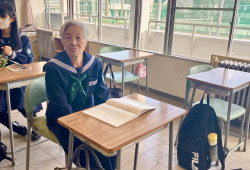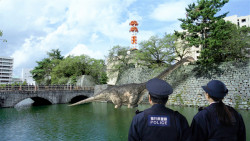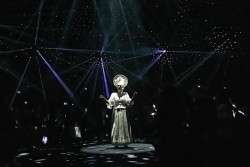
July 1, 2010
Summer Festival Guide ’10
The concert season heats up as the world’s best musicians rock out in Japan
By Metropolis
Originally published on metropolis.co.jp on July 2010

Atoms for Peace. Photo Courtesy of Smash
1. Fuji Rock Festival ’10
The Headliners: Muse, Them Crooked Vultures, Roxy Music, John Fogerty, Massive Attack, Atoms For Peace
Every year on the final weekend of July, a psychedelic tent city springs up from the damp slopes of Mt. Naeba in Niigata Prefecture. This gathering of the wild and woolly is the brainchild of rock promoter Masa Hidaka and his merry pranksters at Smash Corporation. The 14th edition features 161 bands, making for one of the broadest lineups yet.
The headliners break down roughly into three categories: supergroups, heritage acts and local favorites making their umpteenth appearance in Japan. Supergroups include the turbocharged jam session Them Crooked Vultures, featuring none less than Dave Grohl (Nirvana, Foo Fighters) and John Paul Jones (Led Zeppelin). Those two hard-rock warhorses appear on the massive Green Stage in their new roles as drummer and bassist for frontman Josh Homme, of Queens of the Stone Age. Led by Radiohead’s Thom Yorke, Atoms For Peace are a supergroup of an altogether different flavor, with Yorke’s arty musings rising above the sinuous bass lines of sometime Red Hot Chili Pepper Flea.
Heritage acts consist of Roxy Music and John Fogerty. Created by Bryan Ferry in 1971 and at one point featuring Brian Eno, glammy art rockers Roxy Music reformed in 2001 after years of inactivity and have toured sporadically since, with this Fuji Rock gig marking their first appearance in Japan since 1983. Fogerty, meanwhile, was the frontman for American roots rockers Creedence Clearwater Revival, penning definitive songs like “Proud Mary” and “Bad Moon Rising.” Resolving decades of dispute with his record company (but not with his bandmate and brother Tom, who died of AIDS in 1990), Fogerty is back on the road singing CCR songs, making his first showing in Japan in 38 years.
Matthew Bellamy’s stadium-filling Muse, meanwhile, seem to be able to do no wrong. Their latest album, The Resistance, hit number one in 20 countries, and they return to Japan (following a Budokan date in January) for their first appearance at Fuji Rock since 2007. Massive Attack’s theatrical blend of electronica, hip-hop and dub has long made them favorites here, and while their first album in seven years, Heligoland, may have been lackluster, they’re sure to find a warm welcome in a festival-closing set on Sunday night.
Of course, Fuji Rock veterans know that the most fun to be had is at the lesser stages scattered along the pristine river valley. Chancing upon an amazing but unknown band—often the only time they’ll ever come to Japan—at stages like the Naeba Shokudo or Cafe de Paris can often be a lot more fun than mixing it up with the hordes at the White or Green stages.
This year also promises plenty of the usual circus-act hijinks, including appearances by the Human Cannonball and The Wheel of Death, as well as the Narasirato Pan Pipers from the Solomon Islands, who Smash reports didn’t even know what passports were, much less that they needed them to come to Japan.
When: July 30-August 1 Where: Naeba Ski Resort, Niigata Prefecture Tickets: Three-day pass ¥39,800; one-day pass ¥16,800 Tel: 070-5467-6732 Web: www.fujirockfestival.com Fan site: www.fujirockers.org

Jay-Z. Courtesy of Creativeman
2. Summer Sonic 2010
The Headliners: Jay-Z, The Smashing Pumpkins, Stevie Wonder, Dream Theater, Pavement, Pixies
The urban answer to Fuji Rock’s mountain frolic, Summer Sonic scales back to a two-day affair after last year’s flirtation with a three day, Friday-Sunday schedule. Creativeman says this was driven mainly by the difficulty of booking enough strong acts over three days at two locations in Tokyo and Osaka, rather than a lack of fans.
Modeled along the lines of England’s urban Reading Festival, Summer Sonic is a commuting-distance event that caters to a younger demographic with thinner wallets. The lineup is noticeably younger as well, with an increasing emphasis on pop, hip-hop and R&B.
Following last year’s sets by Lady Gaga and Beyoncé, the 2010 edition sees Jay-Z mount a stage in Japan for only the second time, with teen sensation Taylor Swift also making her sophomore appearance following her February debut. Rapper Nas, who has long since settled his feud with Jay-Z, will hopefully lay down some tracks from his highly rated new collaboration with reggae scion Damian Marley, Distant Relatives. Meanwhile, the one and only Stevie Wonder will be on hand to show folks where it all comes from.
Notwithstanding all the R&B, there’s still plenty of rock’n’roll on offer, ranging from alt-rock royalty like The Smashing Pumpkins, Pavement and Pixies to West Coast punk perennials The Offspring to European acts like Richard Ashcroft and Dream Theater, as well as a bevy of new blood hoping to crack the Japanese market.
This year’s edition of Summer Sonic also features a killer Midnight Dance segment with sets from the likes of LA mash-up king Steve Aoki. Over at the Beach Stage, Japan’s own art-rockers Clammbon will be performing songs off their encyclopedic new album 2010.
When: August 7-8 Where: Chiba Marine Stadium and Makuhari Messe Tickets: ¥15,800 (one day); ¥29,000 (both days) Tel: 0180-993-030 Web: www.summersonic.com

Roberta Flack. Courtesy of Tokyo Jazz
3. Tokyo Jazz 2010
The Headliners: Roberta Flack, Al Jarreau, Maceo Parker, Jazz Crusaders, Joshua Redman
In 2002, public broadcaster NHK recruited pianist Herbie Hancock to oversee the launch of a grand new jazz festival in Tokyo. After testing venues ranging from stadiums to convention centers, Tokyo Jazz settled into the elegant Tokyo International Forum, which has proved a good fit for the festival’s well-heeled audiences.
This year’s festival reprises some themes of the past: the opening gala features The Super Premium Band, with pianist Kenny Barron, bassist Ron Carter and drummer Lenny White, while the Saturday afternoon groove session includes former James Brown bandleader Maceo Parker.
TJ 2010 then shifts gears, with a Saturday evening program dubbed The Voices, featuring Roberta Flack and Al Jarreau, and a Sunday morning Women in Jazz section that welcomes drummer Terri Lyne Carrington’s Mosaic Project.
The festival wraps up Sunday night with Jazz Stream, designed to bridge past and present through sets by Dutch free jazz exponent Han Bennink, fusion group the Jazz Crusaders, young-gun sax player Joshua Redman, and guitarist Kazumi Watanabe, reprising his breakout album Tochika with all new arrangements.
When: September 3-5 Where: Tokyo International Forum Tickets: ¥6,500-¥9,500 (individual concerts); ¥18,000 (one-day pass) Tel: Hello Dial 5777-8600 Web: www.tokyo-jazz.com

Kodo. Courtesy of Kodo
4. Earth Celebration
The Headliners: Kodo, A Filetta
Toshio Kawauchi once imagined a festival “for world culture to flow in new directions.” Twenty-two years later, the voyage to Sado Island is undertaken by world music fans from across the globe.
Hosted by storied taiko drum ensemble Kodo at its base on Sado in the Japan Sea, Earth Celebration promotes peace with a week of workshops that culminates in three days of concerts at the hilltop Shiroyama stage.
The drummers of Kodo have been spreading their gospel of peace and unity through music via tireless touring since 1981. Kawauchi added the Earth Celebration to the menu in 1988, inviting musicians whom the group had met on their journeys to join them in the languid atmosphere of their island commune. The grand finale each year sees the guests taking the stage with Kodo for a collaborative performance, with strange but often wonderful results.
Last year’s lineup included Dutch musical explorers BLØF, and this time around Kodo has invited Corsican singing ensemble A Filetta. Founded in 1978 by the then 13-year-old Jean-Claude Acquaviva, the group combines folk songs and hymns with original compositions, dance, theater and opera.
On a practical note, the popularity of the festival in recent years has strained the ability of locals in the tiny town of Ogi to provide accommodation, so those making the trek should be prepared to camp, share lodgings at one of the few minshuku, or stay in another town on the island.
When: August 20-22 Where: Ogi Town, Sado Island, Niigata Prefecture Tickets: prices vary for individual events Tel: 0259-81-4100 Web: www.kodo.or.jp

Tokyo Symphony Orchestra. Courtesy of Tokyo Symphony Orchestra
5. Festa Summer Muza Kawasaki 2010
Tokyo’s many symphony orchestras face the twin problems of how to fill their splendid halls and how to bring a new generation of fans to classical music. To address these issues, the Tokyo Symphony Orchestra—under Dutch conductor Hubert Soudant—created the reasonably priced, three-week Festa Muza Kawasaki.
The festival sees all nine Kanto symphony orchestras joined by a number of world-class guests. Highlights include the Opening Concert, in which the host TSO will perform Schubert’s Unfinished Symphony and Mendelssohn’s A Midsummer Night’s Dream, which features actress Fumi Dan as narrator.
For kids, a Magical Orchestra program on August 1 offers a selection of pieces by composers like Tchaikovsky and Sibelius, all of which have the word “magic” in their title.
When: July 25-August 15 Where: Muza Kawasaki Tickets: A wide range of prices and options available Tel: 044-520-0200 Web: www.kawasaki-sym-hall.jp/festa

Derrick May. Courtesy of Metamorphose
6. Metamorphose 2010
The Headliners: Manuel Göttsching, Mogwai, Derrick May
Ten years ago, renowned techno DJ Mayuri Akama, fed up with the increasingly inane and drug-addicted psychedelic trance scene, sought to broaden the horizons of Japanese electronic music festivals. The result was Metamorphose, which takes in plenty of electronica but also runs in post-rock and experimental directions.
This year’s 11th edition sees the festival comfortably settled into a bicycle racetrack in the hot-spring town of Shuzenji on the Izu peninsula. The bill traces the geographical roots of electronic music from locations as diverse as Detroit, where in the ’80s techno pioneers like Derrick May were engaging in experiments with funk and synth-pop, to Germany, where in the ’70s pioneering guitarist Manuel Göttsching helped to lay the foundations with his influential Inventions for Electric Guitar, which he’ll perform at this summer’s Metamorphose.
While Japan gave electronic music its essential sequencing and sampling gizmos, like the sound-defining Roland 808, Japanese DJs and producers have in turn been influenced by currents from North America and Europe. Mayuri’s deep connections in the local electronic music scene always guarantee a bumper crop of domestic acts. This year, the Boredoms’ Eye (in his DJ incarnation) and keyboard wunderkind Ryota Nozaki aka Jazztronik are among those most likely to put on strong sets. Alternative Japanese rapper Shing02, meanwhile, will be going up against one of the original founders of hip-hop, Grandmaster Flash.
When: September 4 Where: Cycle Sports Center, Shizuoka Prefecture Tickets: ¥11,500 Tel: 03-6431-9020 Web: www.metamo.info

Yuki. ©Epic Records Japan
7. Rock In Japan Fes. 2010
The Headliners: Kreva, Perfume, Mongol800, Unicorn, Yuki, Suga Shikao
Rock In Japan Fes. 2010 celebrates a decade as the country’s largest single-location rock festival, reportedly outdoing even Fuji Rock and Summer Sonic. Launched in 2000 by leading music monthly Rockin’ On, the showcase is the summer counterpart to the equally massive Countdown Japan New Year’s fest at Makuhari Messe.
Spanning three days at a seaside meadow in Ibaraki Prefecture, RIJ covers the gamut from the hip-hop of Kreva to the cyber-pop of Perfume. Recommended acts include singer-songwriter-savant Shugo Tokumaru, whose soaring new opus Port Entropy is one of the year’s best releases in Japan or any country; the King Brothers, whose manic blues-core will make anyone a believer; and Yuki, one of the most creative forces in J-pop despite the halfhearted affair that is her new album, Ureshikute Dakiau Yo.
When: August 6-8 Where: National Hitachi Kaigan Park, Hitachi City, Ibaraki Prefecture Tickets: ¥11,500 (one day); ¥22,000 (two days); ¥30,000 (three days) Tel: 0180-993-611 Web: www.rijfes.co.jp

Takkyu Ishino
8. Also of note
Techno chieftain Takkyu Ishino’s Wire returns to Yokohama Arena on August 28 with the usual posse of Japanese and European DJs and laptop artists…
For the J-pop set there’s Yellow Music Orchestra’s World Happiness 2010 outdoor fest in Shin-Kiba, and record behemoth Avex’s A-nation featuring Ayumi Hamasaki et al. at Ajinomoto Stadium on August 28-29…
Farther afield, Hokkaido’s Rising Sun Festival on August 13-14 keeps going until dawn with a strong line-up of Japanese artists…
Latin music aficionados should head for the magic of the beachside Isla De Salsa festival in Fukuoka on August 7-8…
Looking to October, the not-so-secret Big Secret is Smash’s mini Fuji camp fest Asagiri Jam (yes, you really can see Mt. Fuji), and headbangers’ ball Loud Park at Makuhari Messe, which is looking pretty fierce already with Ozzy Osbourne and Motörhead confirmed.
Losing interest?
With a decline in music sales and a glut of events, are the days numbered for classic fests like Fuji Rock?
After slipping 30 percent in the January-March period, sales of international music now represent just 17 percent of the share of the Japanese market. Against this bleak backdrop, the question arises: are the Japanese losing interest in the kind of groups featured at festivals like Fuji Rock and Summer Sonic?
“I hope the effect won’t be too much, but time will tell.” answers Shinichi “Chris” Kurisawa of FRF organizer Smash. “Recorded music and live shows are two different things, but the slow economy has hurt some of the headline tours for sure.”
“Japanese music sales are also down,” counters Naoki Shimizu, the founder of Creativeman’s Summer Sonic. “Young people don’t split their interests so greatly between Japanese and Western music anymore: they listen to both, and among them are a lot of concertgoers, so I don’t perceive a large influence on Summer Sonic. But it is true that we need strong artists like Lady Gaga to bring new fans to Western pop.”
The closed nature of the domestic recorded music industry and its pervasive influence over television—Coldplay had to agree to perform with Smap in order to get on TV here—mean that Western bands have a better chance in the live music sphere. “I don’t think Japanese are losing interest in foreign music,” says Keith Cahoon, president of music publisher Hotwire and former CEO of Tower Records, “but Japanese labels are concentrating much more on Japanese music, because it is substantially more profitable.”
The increasing reliance of young people on social media and cellphones for their music consumption also works against foreign music in Japan. “One reason for the decline in Western music sales is that young people no longer get their information about music from sources such as radio and print,” says Steve McClure of McClure’s Asia Music News. “Instead, they find out about music from cellphone download services and social media that are much more oriented towards domestic repertoire. And as people get their information about music through digital media that are ‘narrower’ in scope, fewer go to record stores, which were an effective way of exposing consumers to a wide variety of music, including Western.”
Still, the international cachet of Fuji Rock, Summer Sonic, Tokyo Jazz and co. means they’re likely to be around long after Japan’s current festival boom subsides. “Some say there are too many festivals,” says Creativeman’s Shimizu, “but I don’t see Summer Sonic disappearing because we have a unique presence—it’s unlikely that a festival of similar quality will arise.”







